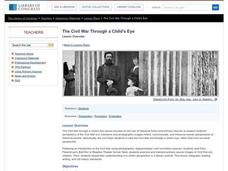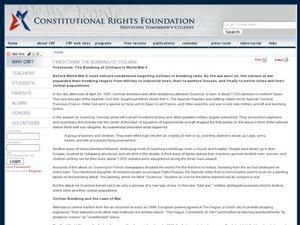Curated OER
Children's Literature Across the Curriculum Ideas-Lincoln: A Photobiography
Students read Lincoln: A Photobiography by Russell Freedman. They complete a variety of cross-curricular activities surrounding the life of Abraham Lincoln, including, but not limited to, the Civil War. Included are reading, art, math,...
Alabama Department of Archives and History
Alabama's Secession in 1861: Embraced with Joy and Great Confidence. Why?
From December 20, 1860 to June 8, 1861, eleven states seceded from the Union. Alabama seceded on January 11, 1861. Why did so many white Alabamians want to secede? Why did they believe the South could win the war? These are the essential...
K20 LEARN
The Emancipation Proclamation: Expanding The Goals Of The Civil War
Should Juneteenth be recognized as a national holiday? To prepare to take a stance on this question, young historians first analyze the Emancipation Proclamation and compare it to Lincoln's first Inaugural Address. Scholars then read an...
Curated OER
Civil War Photography Lesson Plan
Learners explore photographs from the Civil War Era. In this Civil War lesson plan, students consider how photography impacted public opinion of the war as they analyze the provided photographs and discuss the evolution of early...
Curated OER
The Civil War Through a Child's Eye
Learners use primary and secondary sources to observe a child's view of the Civil war. In this Civil War lesson, students understand that different people had different perspectives on the war. Learners recognize the difference between...
Curated OER
Slavery, Manumission, and Freedom: Free Blacks in Charleston before the Civil War
Learners explore the concept of slavery and manumission through a variety of activities. In this civil rights lesson, students gather information from primary sources, then analyze the politics and historical context of the time....
PBS
The Supreme Court: Civil Rights and Civil Liberties
While World War II changed the international order, it also led to a fundamental shift in the concept of civil rights within the United States. Using a video and discussion questions, class members consider the effects the war had to the...
Roy Rosenzweig Center for History and New Media
Reconstruction
When slavery ended, what did the government do to help African American during Reconstruction? An interesting instructional activity uses primary sources such as newspaper articles to help scholars analyze Reconstruction policies and how...
Curated OER
A State of Turmoil
Fourth graders complete a unit about the differences between the northern and southern states after the Revolutionary War. They view various online videos, conduct a debate about the issues that divided the nation, complete a Venn...
Curated OER
Southern Support During the Civil War
Students investigate primary documents to help them answer the question of whether of southern soldiers and citizens abandoned the Confederate cause as the war progressed.
Curated OER
The Vernors Lesson
Students fill out "Effects of the Civil War" question and answer sheet and discover that Vernors was created as a direct result of the Civil War.
American Battlefield Trust
The Home Front
Women and children played key roles during the Civil War, even if their voices are often lost in history. By studying letters and personal testimony from them, budding historians get a glimpse into the day-to-day life of civilians during...
American Battlefield Trust
Contrasting the North and South Before the War
Fundamental differences between the North and South led to the South adopting a system of enslaved labor. These abstract ideas become concrete when class members create a standing cube using information provided in the resource. Young...
Teaching Tolerance
The War on Drugs—Mechanisms and Effects
The war on drugs doesn't have definite results. An interesting lesson plan examines the social, political, and economic effect of the war on drugs. Academics learn how the war on drugs has led to mass incarcerations and negatively...
PBS
An Attack on Syria- What Would You Do?
Has United States military intervention in the conflicts of other countries always been warranted? After reviewing a brief background on contemporary US conflicts and reading articles describing the civil war in Syria, your learners...
National History Day
“Saving the Bear”: The Russian Expeditionary Force of World War One
How have Russian politics affected countries on a global stage? The discussion of the Russian Revolution and World War I begins with an analysis of primary resource letters. Learners finish with a project where they create a timeline of...
Curated OER
Active Viewing: Abraham and Mary Lincoln: A House Divided
Young historians consider the cause and effects of the Emancipation Proclamation. They use handouts, response sheets, and class discussion to build an opinion about the subject after viewing the PBS documentary Abraham and Mary Lincoln:...
Curated OER
The Civil War: From Different Perspectives
Fifth graders look at the Civil War from different perspectives. In this Civil War lesson, 5th graders are divided into groups and take on the role of fictional characters with a real perspective that existed in the Civil War. They...
Curated OER
War, What is it Good for?
Eighth graders examine aspects of the American Civil War related to West Virginia. In this research skills lesson, 8th graders collaborate to research Civil War topics and create electronic portfolios that feature their findings.
Curated OER
Weapons Of War: The Monitor
Students investigate the building of the first warships of the Civil War. They conduct research using a variety of resources. Students compare and contrast two battleships of the era using a graphic organizer. They also compose a journal...
Curated OER
Preservation of Civil War Battlefields
Eighth graders examine the importance of battlefield preservation. In this US History lesson, 8th graders participate in a virtual tour of battle sites. Students create a map of Gettysburg to see the topography of the battle site.
American Battlefield Trust
Pre-1861: Disunion
Nat Turner, John Brown, and Abraham Lincoln all played a key role in the run-up to the bloody American Civil War. Using a PowerPoint, timeline activity, and essay prompt, young historians consider the roles of these men and more to...
Curated OER
Firestorms: The Bombing of Civilians in World War II
Young scholars examine the implication of civilian targets in war. In this World War II lesson, students investigate the history of bombing practices in war. Young scholars zero in on World War II bombing practices as they discuss...
Curated OER
Firing on Fort Sumter
Students assess the difficult position and decision Lincoln had to make. They determine that there were many conflicting opinions at that time. They pretend they are at a dinner table together discussing the current events. They...
Other popular searches
- American Civil War
- Civil War Lesson Plans
- Civil War Inventions
- Civil War Reconstruction
- English Civil War
- Civil War Slavery
- Civil War Flags
- Civil War Battles
- The Civil War
- Civil War Literature
- Civil War and Reconstruction
- Causes of Civil War

























